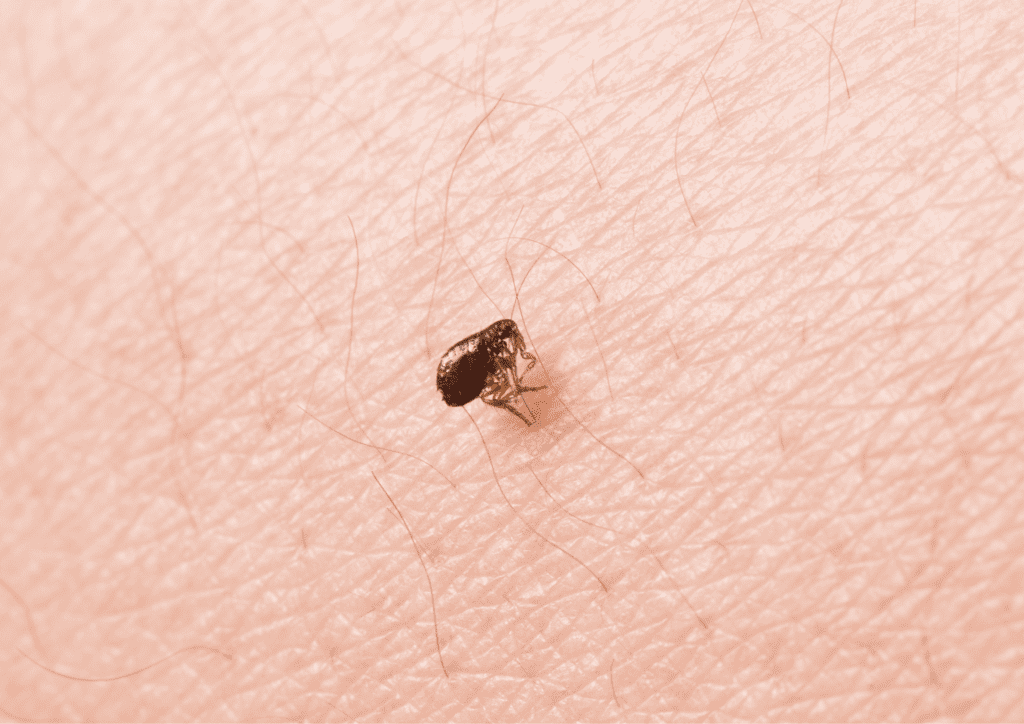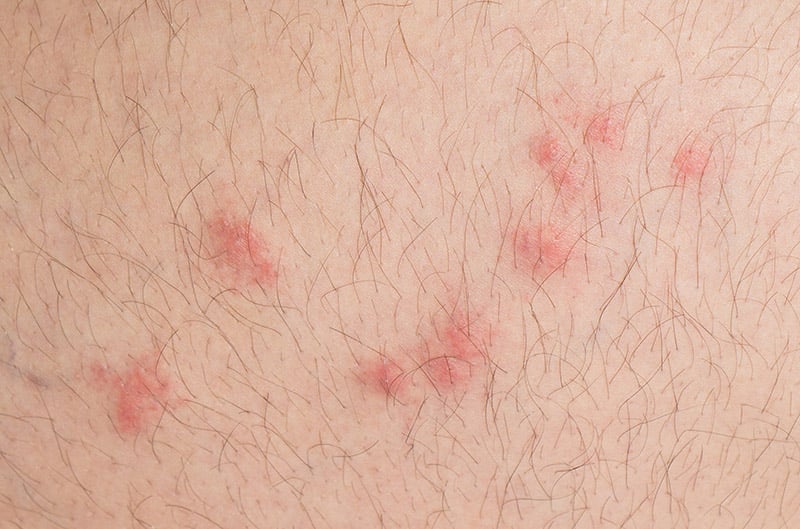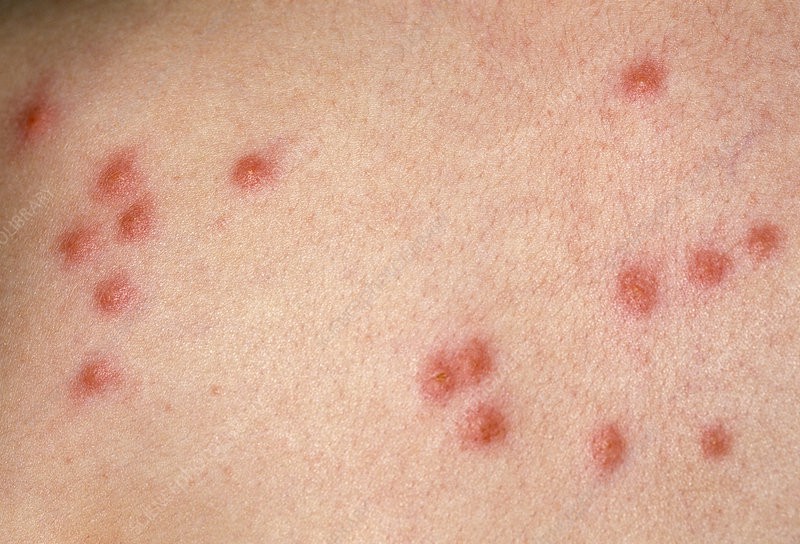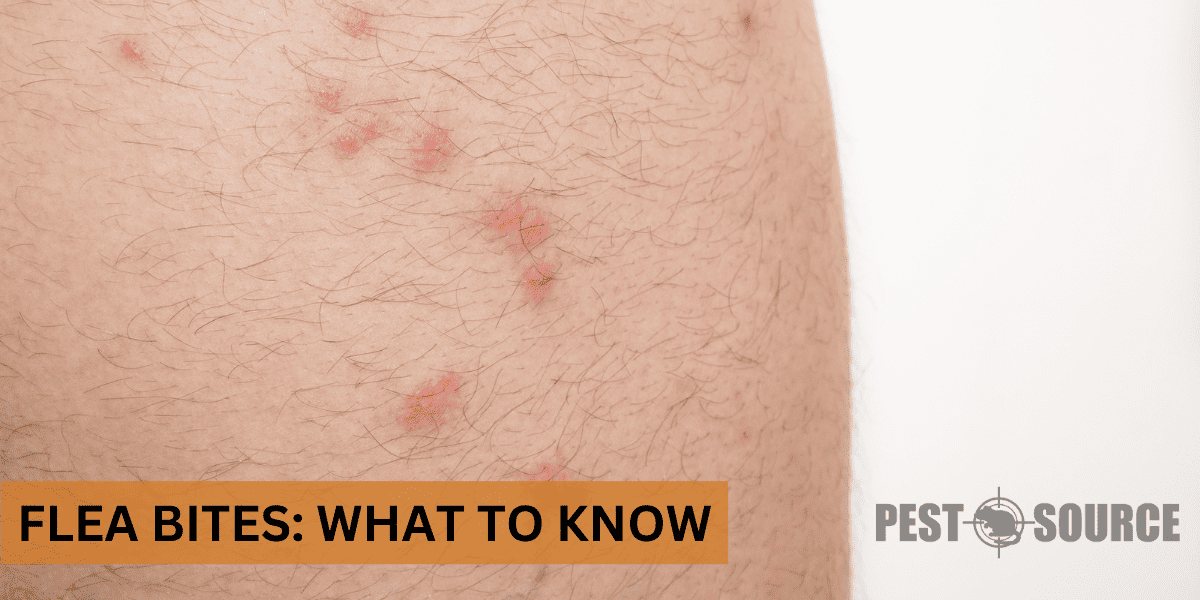Flea bites are a common issue faced by humans and their pets, causing itching, discomfort, and sometimes even more severe reactions. Understanding what flea bites look like, how to differentiate them from other insect bites, and knowing the appropriate treatments can help relieve the distress caused by these nuisances.
In this comprehensive guide, you will learn about flea bites, their symptoms, how to treat them, and effective measures to prevent them in the future. By gaining this knowledge, you can reduce the impact of fleas on your life and maintain a healthy home environment for both you and your pets.
POINTS
- Flea bites are small, red, raised bumps with a red halo, often appearing in lines or clusters on areas like ankles, lower legs, and feet.
- The itching and discomfort caused by flea bites are due to the body’s immune response to the flea’s saliva, which contains substances that trigger the release of histamine.
- Treating flea bites involves cleaning the affected area, applying over-the-counter creams or lotions to reduce itching and inflammation, and avoiding scratching to prevent skin damage or infection.
- Identifying and addressing the source of the flea infestation, such as pets or environmental factors, is crucial in preventing further bites and complications.
- Flea bite prevention includes maintaining a clean home, treating pets for fleas, washing bedding frequently, keeping the yard well-maintained, and using flea repellent products when necessary.
Fleas: An Overview
Understanding the characteristics of fleas and their impact on humans can significantly aid in the prevention and management of flea bites. Below is a table summarizing key flea features, their direct impacts on humans, and the preventative measures that can be taken to mitigate these effects.
| Flea Feature | Impact on Humans | Preventative Measures |
|---|---|---|
| Lifespan | Can live up to several months without a host, increasing chances of infestation. | Regular vacuuming and cleaning of floors, carpets, and pet bedding. |
| Host Preference | Prefer pets but will bite humans if necessary, leading to discomfort and potential allergic reactions. | Use of pet flea treatments and maintaining clean living environments. |
| Reproduction Rate | High reproduction rate leads to rapid population growth in homes. | Employ environmental controls like flea traps and regularly wash pet bedding. |
| Ability to Jump | Can jump long distances, making it easy to move between hosts and areas. | Seal gaps in flooring and doors to limit movement within homes. |
| Disease Transmission | Capable of transmitting diseases like typhus and plague to humans. | Ensure pets are treated for fleas and consult a professional for severe infestations. |
| Environmental Resilience | Survive in various environments, complicating eradication efforts. | Use indoor and outdoor flea control measures, including sprays and yard treatments. |
Can humans get fleas?
Yes, humans can get fleas. While fleas primarily target animals like cats and dogs, they can also feed on human blood when their preferred hosts are not available. Fleas can infest various areas within a home, including carpets, furniture, and bedding, which can lead to bites on people living in the house.
What do fleas do to humans?
Fleas are parasitic insects that feed on the blood of their host. When fleas bite humans, they can cause discomfort, itching, and sometimes skin reactions. Flea bites might not only be a nuisance, but they can also transmit diseases and cause secondary infections.
Can fleas live on human skin?

Fleas prefer to live on furry animals like cats and dogs, but they can occasionally reside on human skin for a short period. However, human skin isn’t an ideal habitat for fleas, so they typically do not establish a long-term infestation on humans. Instead, fleas are more likely to bite people while they’re awake or move between different hosts and hide in the environment.
Can fleas hurt humans, and are they dangerous?
Fleas can hurt humans through their bites, which can cause significant discomfort and itchiness. Flea bites can also be dangerous for humans, as they are capable of transmitting diseases such as typhus and the bubonic plague. Additionally, scratching flea bites can lead to skin damage, secondary infections, and possibly exacerbate allergies.
What are Flea Bites?
What are flea bites?

Flea bites are small, red, itchy bumps that result from the flea puncturing the skin and feeding on blood. These bites often appear as clusters or in a line due to the flea’s movement, and they’re most commonly found on ankles, lower legs, arms, and sometimes the waist.
Do fleas bite humans?
Yes, fleas can bite humans. While they generally prefer to feed on warm-blooded animals like cats and dogs, fleas will bite humans if their preferred hosts are unavailable or if they come into close contact with people. Flea bites can cause itching, discomfort, and possible skin reactions.
Are flea bites bad and are they dangerous to humans?
Flea bites can be considered bad due to the itching, discomfort, and possible skin reactions they cause. They can also be dangerous to humans, as fleas can transmit diseases and infections through their bites. Moreover, scratching the bites can lead to skin damage and secondary infections, making the situation even worse.
Can flea bites make you sick?
While most flea bites aren’t serious and cause only minor skin irritation, some people may experience more severe symptoms from the bites. Fleas can transmit diseases, such as typhus and plague, which can make people sick. Additionally, excessive scratching of flea bites can result in secondary skin infections, which may require medical treatment.
Identifying Flea Bites
What do flea bites look like?

Flea bites appear as small, red, raised bumps on the skin, surrounded by a red halo. They are usually clustered in groups or aligned in a row due to the flea hopping between bites. Flea bites are often confused with other insect bites, so it’s important to know their distinguishing characteristics.
How do flea bites look on a human leg, skin, ankles, and feet?
Flea bites on a human leg, skin, ankles, and feet look like small, red bumps with a red halo around them. They tend to be concentrated on areas of the body where the skin is thinner and blood vessels are closer to the surface because this makes it easier for fleas to feed. Flea bites are often found around the ankles, lower legs, and feet, as these body parts are more likely to come in contact with fleas in the environment.
Do flea bites occur in a line?
Yes, flea bites often occur in a line or as clusters, as the fleas jump from one spot to another while biting and feeding on the blood. This jumping behavior causes the distinct lines or clusters of flea bites, which can help differentiate them from other insect bites.
How can flea bites be differentiated from other insect bites?
Flea bites have distinct characteristics that differentiate them from other insect bites, making it crucial to identify them correctly for appropriate treatment. The table below compares flea bites to those of mosquitoes, bed bugs, and ticks, highlighting key differences in appearance and common symptoms to help you accurately identify flea bites.
| Insect Type | Bite Appearance | Common Symptoms |
|---|---|---|
| Fleas | Small, red, raised bumps often in clusters or lines. | Itching, red halo around the bite. |
| Mosquitoes | Red, puffy bumps that may become hard or swell. | Itching, swelling around the bite area. |
| Bed Bugs | Red, swollen areas with a dark spot at the center of the bite, often found in lines or zigzag patterns. | Itching, burning sensation. |
| Ticks | A small bump under the skin or an area with intense redness. A tick may be found attached at the bite site. | Pain at the bite site, swelling, and sometimes rash or burning sensation. |
Symptoms and Reactions to Flea Bites
Why do flea bites itch and why are they so itchy?
Flea bites itch due to the body’s response to the flea’s saliva, which is injected into the skin during the biting process. The saliva contains substances that prevent blood clotting, allowing the flea to feed efficiently. However, these substances can trigger an immune response in humans, resulting in the release of histamine. Histamine causes itchiness, inflammation, and redness around the bite area.
What are the common symptoms of flea bites?
Common symptoms of flea bites include:
- Red, raised bumps on the skin
- Itching and discomfort
- Inflammation and redness around the bite
- Clusters or lines of bites
In some cases, people may experience more unusual or severe symptoms, such as swelling, hives, or blistering.
How long do flea bites take to show up, and how long do they itch?
Flea bites can show up within minutes to hours after being bitten, depending on the person’s sensitivity to the flea saliva. The itching and discomfort from flea bites typically last for a few days to a week, depending on the severity of the reaction and if the person scratches the bites, causing more irritation.
What does a flea bite rash look like?

A flea bite rash may appear as red, inflamed, flat, or slightly raised areas of irritated skin around the individual bites. The rash typically covers the area where multiple flea bites are clustered, and itchy bumps are sometimes accompanied by oozing or crusting due to repeated scratching.
What is an allergic reaction to flea bites?
An allergic reaction to flea bites occurs when a person’s immune system overreacts to the substances in the flea’s saliva. This can result in more severe symptoms than the usual itching and redness, such as hives, swelling, blistering, extreme itchiness, or even difficulty breathing. If any of these symptoms are observed, it’s crucial to seek medical attention immediately.
Can flea bites cause flea allergy dermatitis in humans?

Flea allergy dermatitis (FAD) is a hypersensitive reaction to flea bites, commonly observed in cats and dogs but can also occur in humans. FAD is caused by an allergy to the flea’s saliva and may result in red, inflamed, and itchy skin, sometimes even wounds and scabs caused by excessive scratching. If you suspect you have flea allergy dermatitis, it’s essential to consult a healthcare professional for proper diagnosis and treatment.
Special Cases: Flea Bites in Specific Populations
Do fleas bite children, and what do those bites look like?

Yes, fleas can bite children just as they bite adults. Flea bites on children look similar to those on adults: small, red, raised bumps with a red halo, often occurring in lines or clusters. Children may be more susceptible to flea bites, as they often play on carpets, floors, or with pets, where fleas might reside.
What do flea bites look like on cats?
Flea bites on cats appear as tiny, red bumps or areas of redness on the skin. These bites can cause severe itching, leading to the cat scratching, licking, or biting the affected areas, which can result in fur loss, skin inflammation, and sometimes, secondary infections.
Can dog fleas bite humans, and what does that look like?
Yes, dog fleas (Ctenocephalides canis) can bite humans, although they prefer to feed on dogs. The bites from dog fleas look similar to those from cat fleas (Ctenocephalides felis), appearing as small, red, raised bumps with a red halo, often found in clusters or lines.
What are the implications of cat flea bites on humans?
Cat flea bites on humans can cause itching, discomfort, redness, and swelling. In some cases, people might develop more severe reactions, such as hives, blisters, or extreme itchiness. Furthermore, cat fleas can also transmit diseases and cause secondary infections if the bites are scratched excessively.
Treatment of Flea Bites
How to treat flea bites on humans?
Treating flea bites effectively requires knowing the right steps to alleviate symptoms and prevent infection. The table below outlines various treatment options for flea bites on humans, including descriptions of each treatment type and their application, to help manage discomfort and promote healing.
| Treatment Type | Description | Application |
|---|---|---|
| Cleaning | Gently wash the bite area with soap and water to prevent infection. | Apply mild soap with water, pat dry with a clean towel. |
| Over-the-Counter Cream | Use hydrocortisone cream or calamine lotion to reduce itching and swelling. | Apply a small amount directly to the bites up to 4 times daily. |
| Antihistamines | Oral antihistamines can help reduce allergic reactions and itchiness. | Take as directed on the package, usually once every 4-6 hours. |
| Ice Packs | Applying ice can reduce swelling and numb the area, decreasing itchiness. | Wrap ice in a cloth and apply to the bite for 10-15 minutes. |
| Avoid Scratching | Scratching can lead to further irritation or infection. | Keep nails short and cover bites with a bandage if necessary to prevent scratching. |
| Professional Medical Advice | Seek medical help if symptoms persist or if an allergic reaction occurs. | Consult a healthcare professional for treatments such as prescription creams or antibiotics. |
What are some effective flea bite cures?
While there are no specific “cures” for flea bites, the above-mentioned treatments can help alleviate symptoms and manage discomfort caused by the bites. Additionally, it’s crucial to address the underlying flea infestation in the home or on pets to prevent further bites and related issues.
How to stop flea bites from itching?
To stop flea bites from itching, you can apply over-the-counter hydrocortisone cream, calamine lotion, or an antihistamine cream to the affected area, which can help reduce the itchiness and inflammation. Avoid scratching the bites, as this can cause further irritation and possibly lead to infections.

How to get rid of flea bites on humans?
Getting rid of flea bites on humans involves treating the symptoms and controlling the source of the infestation. Follow the steps mentioned in the treatment section above to alleviate the symptoms of flea bites. To control the infestation, ensure proper pest management in your home, such as vacuuming frequently, washing bedding, and treating your pets for fleas.
How can flea bites be prevented?
To prevent flea bites:
- Keep your home clean and vacuum regularly to eliminate fleas and their eggs.
- Treat your pets for fleas using medications, collars, or shampoos.
- Wash and change bedding frequently.
- Keep your yard well-maintained and free of debris or tall grass, which can harbor fleas.
- Use flea repellent sprays or products if you often spend time outdoors.
Conclusion
Flea bites can be an irritating and uncomfortable issue for humans and their pets alike. However, by understanding the characteristics of flea bites and how to identify them, you can promptly address these issues and alleviate the symptoms. Proper treatment, effective home maintenance, and taking precautionary measures to control a flea infestation are essential steps in ensuring a safer and more comfortable environment for you and your beloved pets. By following the guidelines discussed in this article, you’ll be better equipped to tackle flea bites and prevent their recurrence, ultimately promoting a healthier and happier life for all.



